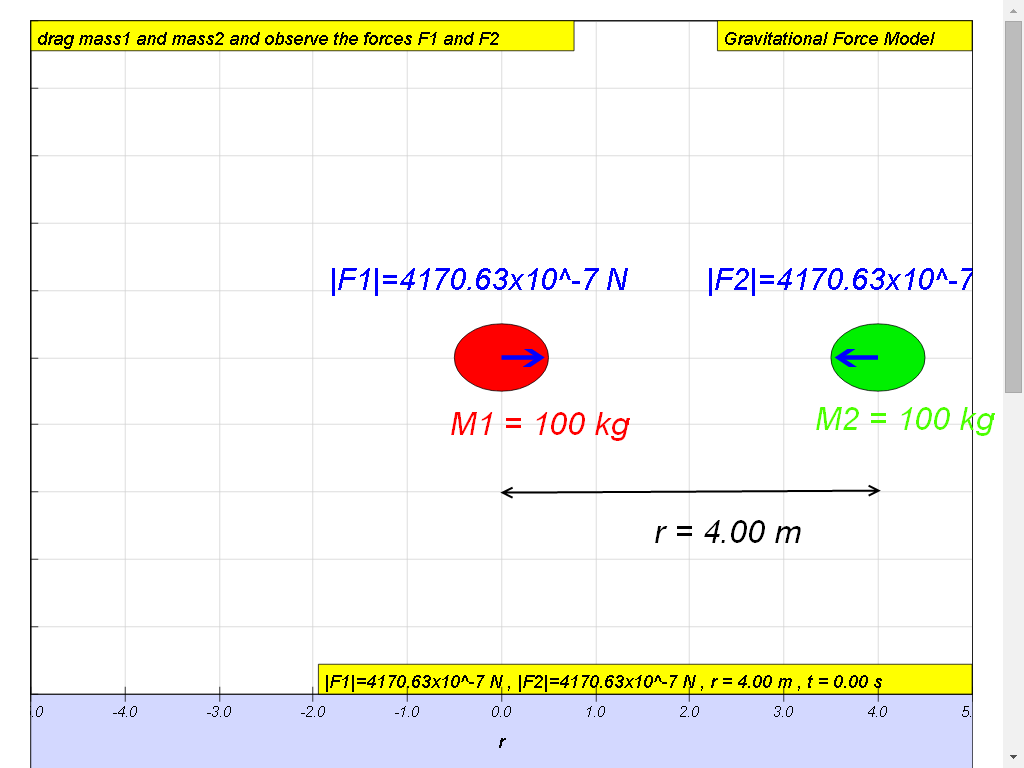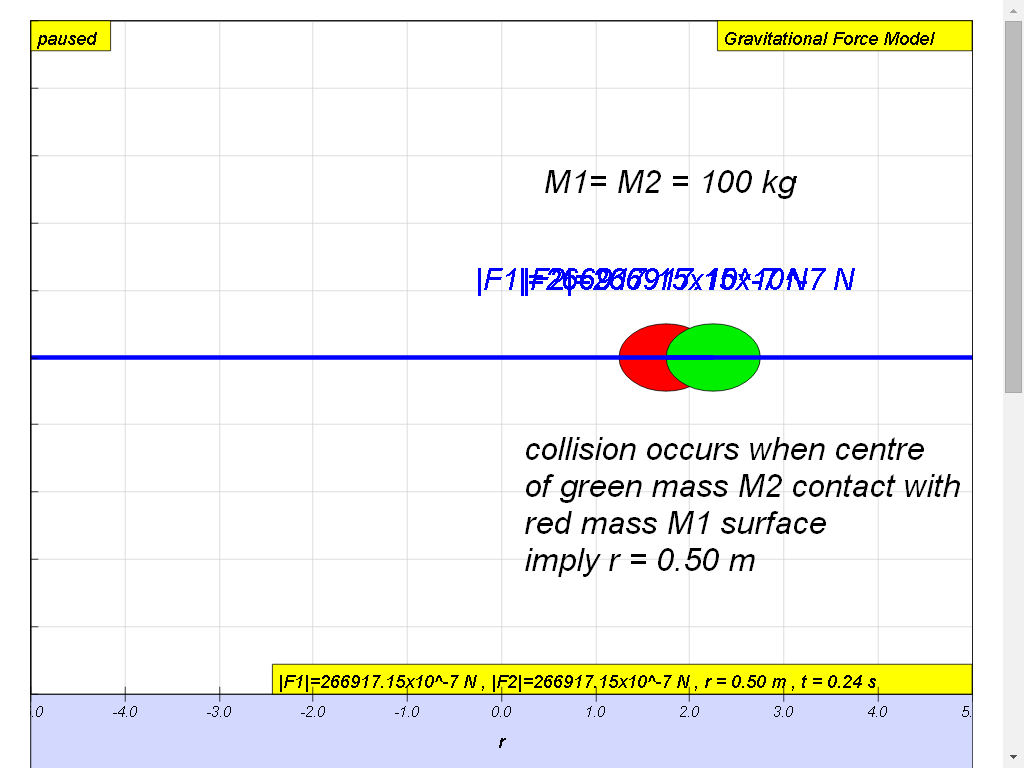Gravitational Field
Learning Outcomes
- Show an understanding of the concept of a gravitational field as an example of field of force and define gravitational field strength as force per unit mass.
- Recall and use
Newton’s law of gravitation in the form
F = G M 1 M 2 r 2 - Derive, from Newton’s
law of gravitation and the definition of gravitational field
strength, the equation
g = GM r 2 - Recall and apply
the equation
g = GM r 2 - Show an appreciation that on the surface of the Earth g is approximately constant and equal to the acceleration of free fall.
- Define potential at a point as the work done in bringing unit mass from infinity to the point.
- Solve problems using
the equation
φ = - GM r - Recognise the analogy between certain qualitative and quantitative aspects of gravitational and electric fields (to be done together with the topic electric fields)
- Analyse circular orbits in inverse square law fields by relating the gravitational force to the centripetal acceleration it causes.
- Show an understanding of geostationary orbits and their application.
Introduction
In the topics of Dynamics, Forces, etc, we have been dealing with weights of different objects. Weight is a name given to the force acting on the object by gravity. In other words, weight is a gravitational force.
Gravitational force is a force that is evident in our everyday lives and plays a crucial role in many processes on Earth. For instance, the ocean tides are caused by the gravitational attraction of both the Moon and Sun on the earth’s oceans.

On Day 0, approximately twice a month, around new moon when the Sun, Moon, and Earth form a line (a condition known as syzygy), the tidal force due to the sun reinforces that due to the Moon.

On Day 7, hour =9, when the Moon is at first quarter, the sun and Moon are separated by 90° when viewed from the Earth, and the solar tidal force partially cancels the Moon's. At these points in the lunar cycle, the tide's range is at its minimum; this is called the neap tide, or neaps (a word of uncertain origin).

On Day 14, hour = 18, around full moon when the Sun, Moon, and Earth form a line (a condition known as syzygy), the tidal force due to the sun reinforces that due to the Moon.

Day 22, hour =3, when the Moon is at third quarter, the sun and Moon are separated by 270° when viewed from the Earth, and the solar tidal force partially cancels the Moon's. At these points in the lunar cycle, the tide's range is at its minimum; this is called the neap tide, or neaps (a word of uncertain origin).
The java required model download here https://dl.dropboxusercontent.com/u/44365627/lookangEJSworkspace/lookangejss/02_newtonianmechanics_7gravity/ejs/ejs_model_MoonPhases.jar

At the end of the lunar cycle on the Day 29, 12 hours, around new moon when the Sun, Moon, and Earth form a line (a condition known as syzygy), the tidal force due to the sun reinforces that due to the Moon.
The falling of objects when released is also caused by the gravitational pull of the Earth on all objects. In terms of planetary motion, gravitational force is responsible for keeping the Earth in its orbit around the Sun, which in turns gives rise to four seasons in some countries.
Newton’s Law of Gravitation
Gravitation is a natural phenomenon by which physical bodies attract each other due to their masses. This force occurs whenever masses are present and the two bodies need not to be in contact with each other. It is however the weakest of the fundamental forces of nature.In 1687, Sir Isaac Newton concluded that this non-contact gravitational force must be as responsible for the falling of the apple from a tree as it is the cause for the rotation of the moon about the earth. Hence he published the Newton’s law of gravitation which states that:
“The mutual force of attraction between any two point masses is
directly proportional to the product of their masses and
inversely proportional to the square of the separation between their centres.”
This means that if there are two point masses M and m and they are separated by distance r, the magnitude of the gravitational force attracting them to each other is
| F | =
where G, the constant of universal gravitation, is
Note:
1. r is taken to be the centre to centre distance (i.e. centre of particle to centre of particle). Do not take r to be the radius of orbit!
2. This formula is an example of the inverse square law.
Inquiry:
1) What can you conclude about the two forces in the above diagram?
at time of collision, t = 0.24 s, r = 0.50 m, the forces F1 (still acts on M1 points towards right or M2) and F2 (acts on M2 points towards left or M1) respectively can be calculate to be
In the model below, you can drag to change the position of M1 and M2 to observe the directions of the F1 and F2 pairs. What can you conclude about the relationship about them?
Are they Newton's third law: action-reaction pair ( equal in magnitude, opposite in direction and act on different bodies).
Next, vary the mass of M2 to zero value, what did you observe in terms of the magnitude/value of F1 ? Can you conclude that F1 and F2 exists as a consequent of their masses influencing each other?
Hence, evidences suggests that the two forces in the diagram are action-reaction pair because each force is acting on the particle by the other particle.
2) In that case, when Earth pulls you down, why did you not pull Earth up?
Observe that the M1 is indeed influenced by the M2 because F1 exists and M1 did move a bit to the right. But because the mass M1 is larger than , M1 acceleration to the left is smaller.
Try for yourself, and key in the mass of Earth = 6.0x1024 kg as 6e24 into the field for M1 and your mass into the M2 field.
Click the play icon and what did you observe?
You did! it can be observe that the your mass M2 did pull on Earth but the Earth only accelerate very little towards M2.
Estimate the gravitational force exerted between you and your nearest neighbor in this lecture theater.
answer:
Assume that both masses are 100 kg each and the distance between the centres of gravity of the two persons is 1.00 m.Magnitude of the force
(Note: This force is really small)
3) using the model, design an inquiry approach for asking the question: is the relationship of the force on mass 1 due to mass 2, |F1| and mass 2 due to mass 1 |F2| on each other and their centre to centre distances apart r ?
(hints: ask the question: is the relationship of the force on mass 1 due to mass 2, |F1| and mass 2 due to mass 1 |F2| on each other and their centre to centre distances apart r ? is the model





